| Weight | 1 lbs |
|---|---|
| Dimensions | 9 × 5 × 2 in |
| host | mouse |
| isotype | IgG2a |
| clonality | monoclonal |
| concentration | concentrate, predilute |
| applications | IHC |
| reactivity | human |
| available size | 0.1 mL, 0.5 mL, 1 mL concentrated, 7 mL prediluted |
mouse anti-p63 monoclonal antibody (4A4) 6316
Price range: $160.00 through $528.00
Antibody summary
- Mouse monoclonal to p63
- Suitable for: Immunohistochemistry (formalin-fixed, paraffin-embedded tissues)
- Reacts with: Human
- Isotype:IgG2a
- Control: Skin or prostate
- Visualization: Nuclear
- 0.1, 0.5, 1.0 mL concentrated, 7 mL prediluted
mouse anti-p63 monoclonal antibody 4A4 6316
| target relevance |
|---|
| Protein names Tumor protein 63 (p63) (Chronic ulcerative stomatitis protein) (CUSP) (Keratinocyte transcription factor KET) (Transformation-related protein 63) (TP63) (Tumor protein p73-like) (p73L) (p40) (p51) |
| Gene names TP63,TP63 KET P63 P73H P73L TP73L |
| Protein family P53 family |
| Mass 76785Da |
| Function FUNCTION: Acts as a sequence specific DNA binding transcriptional activator or repressor. The isoforms contain a varying set of transactivation and auto-regulating transactivation inhibiting domains thus showing an isoform specific activity. Isoform 2 activates RIPK4 transcription. May be required in conjunction with TP73/p73 for initiation of p53/TP53 dependent apoptosis in response to genotoxic insults and the presence of activated oncogenes. Involved in Notch signaling by probably inducing JAG1 and JAG2. Plays a role in the regulation of epithelial morphogenesis. The ratio of DeltaN-type and TA*-type isoforms may govern the maintenance of epithelial stem cell compartments and regulate the initiation of epithelial stratification from the undifferentiated embryonal ectoderm. Required for limb formation from the apical ectodermal ridge. Activates transcription of the p21 promoter. {ECO:0000269|PubMed:11641404, ECO:0000269|PubMed:12374749, ECO:0000269|PubMed:12446779, ECO:0000269|PubMed:12446784, ECO:0000269|PubMed:20123734, ECO:0000269|PubMed:22197488, ECO:0000269|PubMed:9774969}. |
| Subellular location SUBCELLULAR LOCATION: Nucleus {ECO:0000269|PubMed:12446779, ECO:0000269|PubMed:20123734}. |
| Tissues TISSUE SPECIFICITY: Widely expressed, notably in heart, kidney, placenta, prostate, skeletal muscle, testis and thymus, although the precise isoform varies according to tissue type. Progenitor cell layers of skin, breast, eye and prostate express high levels of DeltaN-type isoforms. Isoform 10 is predominantly expressed in skin squamous cell carcinomas, but not in normal skin tissues. {ECO:0000269|PubMed:11248048, ECO:0000269|PubMed:9774969}. |
| Structure SUBUNIT: Binds DNA as a homotetramer. Isoform composition of the tetramer may determine transactivation activity. Isoforms Alpha and Gamma interact with HIPK2. Interacts with SSRP1, leading to stimulate coactivator activity. Isoform 1 and isoform 2 interact with WWP1. Interacts with PDS5A. Isoform 5 (via activation domain) interacts with NOC2L. {ECO:0000269|PubMed:10373484, ECO:0000269|PubMed:11925430, ECO:0000269|PubMed:12374749, ECO:0000269|PubMed:17846787, ECO:0000269|PubMed:18806757, ECO:0000269|PubMed:20123734, ECO:0000269|PubMed:9662346}. |
| Post-translational modification PTM: May be sumoylated. {ECO:0000250}.; PTM: Ubiquitinated. Polyubiquitination involves WWP1 and leads to proteasomal degradation of this protein. {ECO:0000269|PubMed:18806757}. |
| Domain DOMAIN: The transactivation inhibitory domain (TID) can interact with, and inhibit the activity of the N-terminal transcriptional activation domain of TA*-type isoforms. {ECO:0000269|PubMed:12446779, ECO:0000269|PubMed:12446784}. |
| Involvement in disease DISEASE: Acro-dermato-ungual-lacrimal-tooth syndrome (ADULT syndrome) [MIM:103285]: A form of ectodermal dysplasia. Ectodermal dysplasia defines a heterogeneous group of disorders due to abnormal development of two or more ectodermal structures. ADULT syndrome involves ectrodactyly, syndactyly, finger- and toenail dysplasia, hypoplastic breasts and nipples, intensive freckling, lacrimal duct atresia, frontal alopecia, primary hypodontia and loss of permanent teeth. ADULT syndrome differs significantly from EEC3 syndrome by the absence of facial clefting. Inheritance is autosomal dominant. {ECO:0000269|PubMed:11929852}. Note=The disease is caused by variants affecting the gene represented in this entry.; DISEASE: Ankyloblepharon-ectodermal defects-cleft lip/palate (AEC) [MIM:106260]: An autosomal dominant condition characterized by congenital ectodermal dysplasia with coarse, wiry, sparse hair, dystrophic nails, slight hypohidrosis, scalp infections, ankyloblepharon filiform adnatum, maxillary hypoplasia, hypodontia and cleft lip/palate. {ECO:0000269|PubMed:11159940}. Note=The disease is caused by variants affecting the gene represented in this entry.; DISEASE: Ectrodactyly, ectodermal dysplasia, and cleft lip/palate syndrome 3 (EEC3) [MIM:604292]: A form of ectodermal dysplasia, a heterogeneous group of disorders due to abnormal development of two or more ectodermal structures. It is an autosomal dominant syndrome characterized by ectrodactyly of hands and feet, ectodermal dysplasia and facial clefting. {ECO:0000269|PubMed:10535733, ECO:0000269|PubMed:10839977, ECO:0000269|PubMed:11462173, ECO:0000269|PubMed:12838557}. Note=The disease is caused by variants affecting the gene represented in this entry.; DISEASE: Split-hand/foot malformation 4 (SHFM4) [MIM:605289]: A limb malformation involving the central rays of the autopod and presenting with syndactyly, median clefts of the hands and feet, and aplasia and/or hypoplasia of the phalanges, metacarpals, and metatarsals. Some patients have been found to have intellectual disability, ectodermal and craniofacial findings, and orofacial clefting. {ECO:0000269|PubMed:10839977, ECO:0000269|PubMed:11462173}. Note=The disease is caused by variants affecting the gene represented in this entry.; DISEASE: Limb-mammary syndrome (LMS) [MIM:603543]: Characterized by ectrodactyly, cleft palate and mammary-gland abnormalities. {ECO:0000269|PubMed:11462173, ECO:0000269|PubMed:32067224}. Note=The disease is caused by variants affecting the gene represented in this entry.; DISEASE: Rapp-Hodgkin syndrome (RHS) [MIM:129400]: A form of ectodermal dysplasia, a heterogeneous group of disorders due to abnormal development of two or more ectodermal structures. Characterized by the combination of anhidrotic ectodermal dysplasia, cleft lip, and cleft palate. The clinical syndrome is comprised of a characteristic facies (narrow nose and small mouth), wiry, slow-growing, and uncombable hair, sparse eyelashes and eyebrows, obstructed lacrimal puncta/epiphora, bilateral stenosis of external auditory canals, microsomia, hypodontia, cone-shaped incisors, enamel hypoplasia, dystrophic nails, and cleft lip/cleft palate. RHS inheritance is autosomal dominant. {ECO:0000269|PubMed:12766194, ECO:0000269|PubMed:12939657, ECO:0000269|PubMed:15200513}. Note=The disease is caused by variants affecting the gene represented in this entry.; DISEASE: Orofacial cleft 8 (OFC8) [MIM:618149]: A birth defect consisting of cleft lips with or without cleft palate. Cleft lips are associated with cleft palate in two-third of cases. A cleft lip can occur on one or both sides and range in severity from a simple notch in the upper lip to a complete opening in the lip extending into the floor of the nostril and involving the upper gum. {ECO:0000269|PubMed:16740912}. Note=The disease is caused by variants affecting the gene represented in this entry.; DISEASE: Premature ovarian failure 21 (POF21) [MIM:620311]: A form of premature ovarian failure, an ovarian disorder defined as the cessation of ovarian function under the age of 40 years. It is characterized by oligomenorrhea or amenorrhea, in the presence of elevated levels of serum gonadotropins and low estradiol. POF21 inheritance is autosomal dominant. {ECO:0000269|PubMed:30924587, ECO:0000269|PubMed:35801529, ECO:0000269|PubMed:36856110}. Note=The disease is caused by variants affecting the gene represented in this entry. Gain-of-function variants located in the transactivation inhibition domain are responsible for premature ovarian failure by inducing accelerated oocyte loss, as shown in mutant mice carrying the pathogenic variant p.Arg647Cys. {ECO:0000269|PubMed:36856110}. |
| Target Relevance information above includes information from UniProt accession: Q9H3D4 |
| The UniProt Consortium |
Data
 |
| Human breast stained with anti-p63 using peroxidase-conjugate and DAB chromogen. Note nuclear staining of myoepithelial cells. |
Publications
| pmid | title | authors | citation |
|---|---|---|---|
| We haven't added any publications to our database yet. | |||
Protocols
| relevant to this product |
|---|
| IHC |
Documents
| # | SDS | Certificate | |
|---|---|---|---|
| Please enter your product and batch number here to retrieve product datasheet, SDS, and QC information. | |||
Only logged in customers who have purchased this product may leave a review.

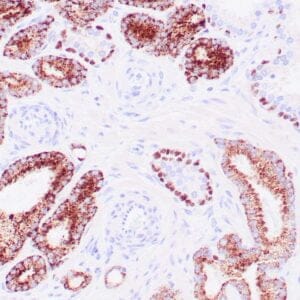
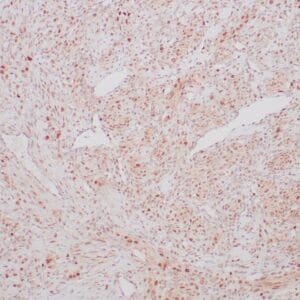
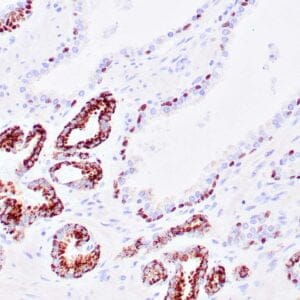

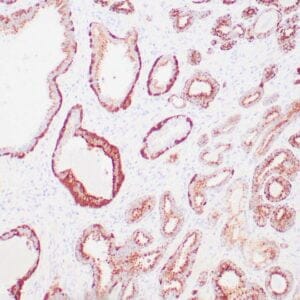
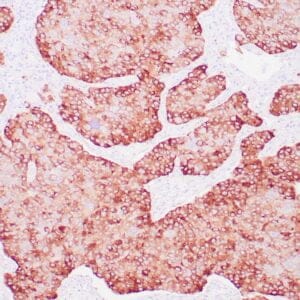
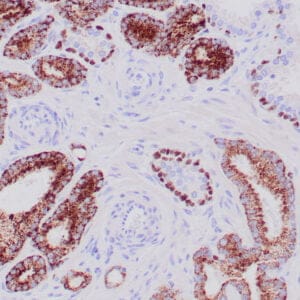


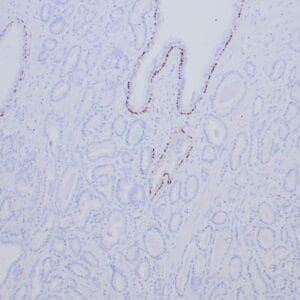
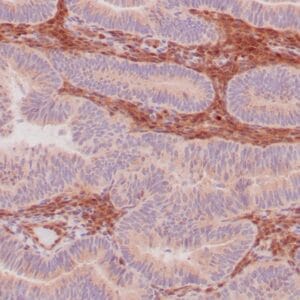
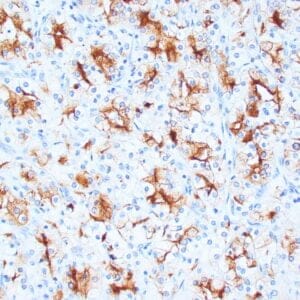

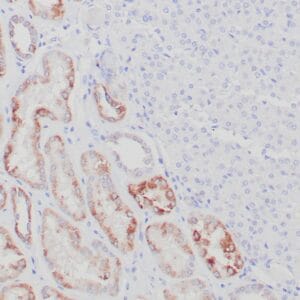
Reviews
There are no reviews yet.